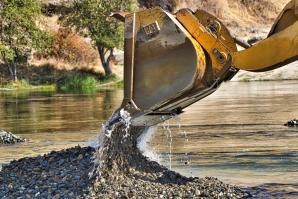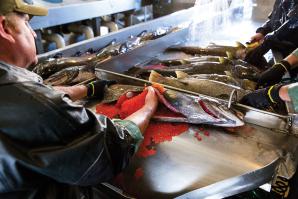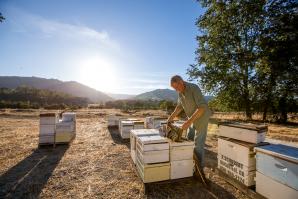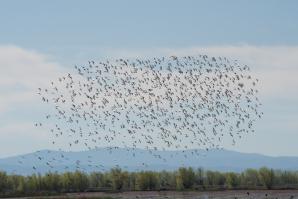On a warm August afternoon, a small fleet of tractors are busy in what seems to be an effort to smother the American River with rubble. The vehicles kick up dust and spew fumes as they gouge away at a heap of gravel on the river banks, just a stone’s throw downstream from the Nimbus Dam. Scoop by scoop, they shuttle the debris to the river and unload it in the current.
But what appears to be the beginning of a new development project is nothing of the sort. Rather, these machines are trying to save fish. Hired by the U.S. Bureau of Reclamation, the tractors are transferring tons of pebbles into the middle of the American River for the benefit of Chinook salmon. By September, what had been a heavily eroded streambed would be a prime spot for fish to spawn.
Related: Photos of the Salmon and Steelhead Restoration Project
Such habitat improvement efforts, along with fish hatcheries and truck transport of juvenile fish to the sea, are a key part of the expensive life-support system that keeps Chinook salmon alive and running in the waters of the Central Valley. Now, programs like the restoration of the American River’s gravel beds could receive a funding boost worth hundreds of millions of dollars, thanks to the Proposition 1 water bond passed by California voters in early November. The $7.5 billion package promises to bolster groundwater supplies, increase storage capacities, develop desalination infrastructure, and protect and restore watersheds in the decades ahead. Farmers, foreseeing more reliable irrigation supplies, have celebrated the passage of the bond. Powerful environmental groups like NRDC, Trout Unlimited and The Nature Conservancy also supported the measure as it moved toward the ballot.
But some scientists and environmentalists fear the water bond could drive the demise of the Sacramento-San Joaquin Delta ecosystem and California’s iconic Chinook salmon runs, which have sagged perilously at times in the past decade. Bond funding, which will eventually be dispensed by various state agencies, could help improve habitat conditions both for spawning adult fish and newly born juveniles. However, fishery advocates believe other directives in the bond will offset such efforts and ultimately lead to diminished flows of water in rivers where the fish reproduce.
Of particular concern for some is that the bond allocates $2.7 billion toward increasing water storage, possibly with new dams and reservoirs. At least two new reservoir locations — one near Fresno, another in the western Sacramento Valley — have been proposed. Central Valley farmers would almost certainly benefit from such new developments, but how — or if — these projects would help aquatic ecosystems is debatable.
“One of the main arguments for the dams from supporters is that dams will make for more flexibility in releasing water for fish,” says Peter Moyle, a fisheries biologist at UC Davis. “But obviously, the main reason for having dams is to have better flexibility for providing water for farmers. The environment just becomes justification for it.”
The water bond specifies that any new storage projects resulting from the measure must produce a real benefit for aquatic ecosystems, fish and wildlife. Todd Manley and David Guy, colleagues at the Northern California Water Association, have faith this stipulation will steer the operation of any new reservoirs. Manley points out that the more northerly of the two suggested reservoir locations would not be built in the path of any migrating salmon, as scores of other dams have been. The project would flood the arid Antelope Valley, near the town of Maxwell, with water diverted from the Sacramento River in periods of high flows. Once filled, the reservoir could serve to release cool water at strategic times to help migrating adult fish swim upriver and migrating smolts swim down. The other proposed new reservoir would be created upstream of Millerton Lake, on the San Joaquin River system. How this project would benefit the public or fisheries, and not just agriculture, has been less clearly outlined.
“One of the main arguments for the dams from supporters is that dams will make for more flexibility in releasing water for fish. But obviously, the main reason for having dams is to have better flexibility for providing water for farmers. The environment just becomes justification for it.” Peter Moyle, fisheries biologist, UC Davis
But Barbara Barrigan-Parrilla, executive director of an environmental group Restore the Delta, doesn’t believe any promises that ecological benefits could come with the dams.
“Everywhere else in the nation, they are tearing down dams to benefit fish,” she says. “Only in California are leaders telling us that building dams will benefit fish.”
She suspects that powerful agriculture groups, in collusion with lawmakers, are attempting to unroll a long-term plan of weakening environmental protections and accelerating the flow of Northern California’s water to farms in the San Joaquin Valley. Private interests — largely corporate farms — and not the public, she says, will profit.
John McManus is also skeptical that new dams will alleviate pressures on the environment. Rather, McManus, the Golden Gate Salmon Association’s executive director, thinks storing more water will simply fuel more demand.
“History tells us that every time we make new water storage, we create new water addicts,” he says. The federal Central Valley Project, for example, saw the construction of massive dams and conveyance canals in the 1940s and 1950s. The similar State Water Project followed. This era of hydroengineering gave rise to the Westlands Water District southwest of Stockton. Today, this arid region is home to some of the most productive farms in the state, and farmers here, who are steadily planting more fruit trees — especially almonds — are endlessly grasping for water. Although law states that Westlands’ farmers, as “junior water rights” holders, must forfeit their water in dry times, the district has multiple times sued the government when their irrigation canals ran low. McManus worries that new reservoirs full of water will not slake these farmers’ thirst but stoke it.
But Proposition 1 also includes what some environmentalists see as a beacon of hope — $1.5 billion in allocations to watershed protection and restoration. For instance, $327 million has been reserved for various conservancies around the state, including the State Coastal Conservancy and the Ocean Protection Council, and $200 million has been committed to enhancing stream flows. Moyle warns that this latter sum may be too little to make a great splash unless it is dedicated to just a few strategically chosen streams. He would like to see part of it spent on managing a Klamath tributary called the Shasta River, once the destination for 80,000 spawning Chinook each year, as well as Battle Creek, an important salmon producer on the Sacramento system. Because these streams are spring-fed, they have the potential to run cold and clear every month of the year, Moyle explains.
“For salmon, that makes them important refuges in times of drought,” he says.
Buying water rights from landowners adjacent to such important spawning streams, and perhaps fencing the stream banks to guard the water from cattle damage, could protect the natural spawning beds for tens of thousands of Chinook and steelhead every year.
Restoring gravel beds downstream of major dams might be another worthy use of millions. Gravel is almost as crucial to successful salmon spawning as is cold, clean water, but because of dams like Shasta and Nimbus, gravel stacks up behind the cement barriers while gravel beds downstream are washed away by the current, leaving bare bedrock and no place for fish to lay eggs.
Carson Jeffres, a biologist with the UC Davis Center for Watershed Sciences, says spawning habitat is critical if salmon are to persist in California. But he says restoring wetlands downstream near the Delta will be just as important. Sloughs and side channels, drained long ago by local landowners, could be flooded anew with moving water and would provide shelter for newly born salmon, which otherwise may experience heavy predation from birds and bigger fish in the open channels of the river’s main stem. Research has clearly shown that salmon juveniles reared in flooded rice paddies grow fatter, fitter and stronger faster than their same-age siblings left to fend for themselves in the swift currents of the Sacramento River.
“We need to make sure that all the life stages [of salmon] are accounted for, not just the obvious ones, like spawning,” Jeffres says.
But Jeffrey Mount, a UC Davis geology professor and hydrology expert, isn’t confident the water bond’s habitat improvement money will hit the right targets or hit them hard enough.
“We should not expect miracles when you have an infusion of money from bonds,” Mount says. “Bond money gets spent rapidly, whereas what we need for habitat improvement for salmon is ongoing maintenance programs through many years.”
Moreover, relatively little bond funding will land in the Delta, a region that the decades have transformed from an important wetland nursery for young fish into an extremely dangerous system of fast-moving, cement-lined channels and sloughs thick with predators. Just $50 million is reserved for Delta-specific improvements. “That sounds like lots of money, but in habitat restoration projects, that will go very quickly,” Mount says. “If we don’t deal with the Delta, we cannot solve the problems [facing juvenile salmon survival].”
Proposition 1 is not the first effort to assist the ailing aquatic ecosystem of the Sacramento-San Joaquin river system. The California Federal Bay-Delta Program, or CalFed, was launched in 2000 with the Delta-oriented goals of restoring fish populations, improving water quality, improving reliability of deliveries and reducing the risk of levee breach. By 2007, CalFed, which had sent vast sums of money around the state to a variety of vaguely water-oriented programs, was widely recognized as a failure, with fish populations still on the brink and several billion dollars washed down the drain.
Meanwhile, state and federal laws already require that waterways, even with dams and diversion systems in place, be managed and protected for the benefit of native fish. The Central Valley Project Improvement Act, passed by Congress in 1992, required — and still does require — natural runs for spawning salmon in the Central Valley be restored to and maintained at twice their recent historical abundance. But the CVPIA has failed to realize this goal. Central Valley salmon runs have struggled in the past decade and even scored record low returns in 2009.
Then there is the state’s Fish and Game Code, in which Section 5937 declares that “the owner of any dam shall allow sufficient water at all times to pass over, around or through the dam, to keep in good condition any fish that may be planted or exist below the dam.” But according to a study coauthored by Moyle and published last October in the journal BioScience, 181 dams in the state are impeding the survival of native fish downstream. The authors noted that it usually takes a lawsuit to enforce fish-protecting laws.
In light of such conspicuous failures to save the Delta and California’s fisheries, water policy analyst and author David Zetland predicts most of the funding intended for habitat restoration will be spent on feasibility studies and consulting fees. Then, funds will run out before any benefits for wetlands and fish are realized.
Anyway, California’s chief water-related challenge is that too many users are scrapping over too little water, Zetland says. Agriculture is guzzling the lion’s share of river diversions, and farmers are now overdrawing groundwater supplies. Many environmentalists believe water bankruptcy is in our future unless agricultural growth is curtailed — and the water bond, Zetland says, does not significantly change this.
“Even if we build new dams and the Delta tunnels, agriculture is using more water than the ecosystem can handle,” he says. “The water bond does not fix any fundamental water problems.”
Guy, with the Northern California Water Association, feels there is no room or time for pessimism if salmon populations are to be maintained in California’s heavily populated and water-strapped environment. Voters, he notes, have already passed the bond.
“We have to be optimistic,” he says. “That’s how we get things done.”
Recommended For You

Fishy Repairs: The Salmon and Steelhead Restoration Project
As part of the Salmon and Steelhead Restoration Project, workers haul rubble to the shores of the American River just downstream from the Nimbus Dam, in an effort to restore streambeds.

Counting Roe
The spawn of a salmon
Andy Heape has been a California Department of Fish and Wildlife technician at the Nimbus Fish Hatchery in Gold River — where he sorts, fertilizes and counts salmon — for 15 years.

As the Bees Go
Local beekeepers prepare for another uncertain winter
Rick Schubert is settling in to the part of bee season that didn’t exist when he opened Bee Happy Apiary with 300 hives in 1977. It’s mid-September, and at headquarters, tucked in the dusty hills off a private road in Vacaville, the faint humming of honey bees serves as background buzz to the voices of men.

Water Foul
The drought is putting in jeopardy efforts to shore up migratory bird populations
Doug Thomas stops his white pickup along the elevated dirt road that carves through the acres of newly planted rice stalks in Wheatland, Calif.
In this scene, replete with a myriad of migratory birds lazily grazing in the green fields, change is soon to come. The landscape, Thomas says, will be transformed into an oasis for waterfowl and shorebirds that will find a man-made wetlands to call home on their annual migration this fall.




Comments
Why was there no mention of big oil or how much water they will get? Or why we allow those corporations to then inject that now polluted water back into the same fields we grow our food in? Other than that it was a very good article.
Dams are a necessity. We have a water problem, the only way to save water is to build dams. What I have seen year after year a failed water management from the dams. To much water let out in anticipation of a heavy winter and run off. What good is a dam if you let all the water out for recreation etc... More dams hold the water and only let out for fish and farming and run the hydroelectric generators.